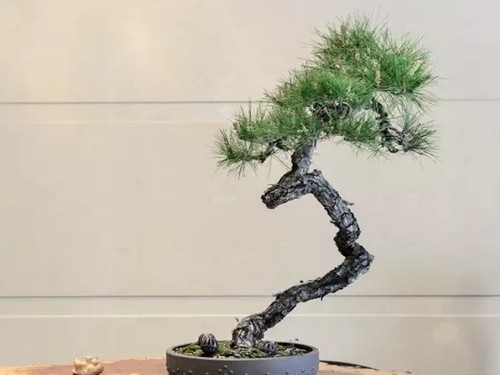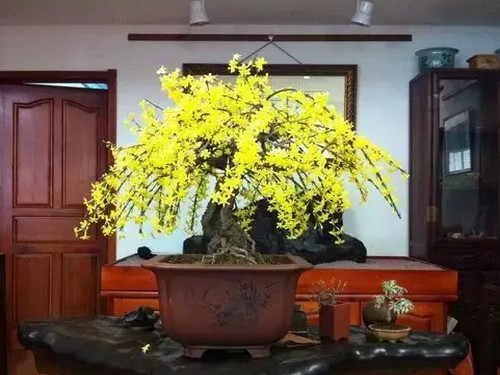Material selection and cultivation of Pushu bonsai
Pu Shu's posture is quaint and chic, the bark is uncracked, the stem shape is tall and straight, the branches are whirling, the new leaves are released at the beginning of spring, the branches are green, and the leaves are dark yellow in autumn. The fallen leaves are almost gone in winter, which can be enjoyed as a cold tree. Take its old stump, dew root qu dry, Qiu qu simple, green leaf branches, cascading towering, very rich mountain forest wild interest. Pushu is a deciduous tree of nettle order, distributed in Henan, Shandong, the middle and lower reaches of the Yangtze River and southern provinces, as well as Taiwan, Vietnam and Laos. This kind of tree is often cultivated for bonsai.
The bark of Pushu is smooth and gray in color. it is characterized by alternate leaves, long petiole, leathery leaf blade, broadly ovate to narrowly ovate, apex acute to acuminate, base rounded or broadly cuneate, oblique, shallowly serrate above the middle, Ternate veins, glabrous above, sparsely hairy along veins and axils below. Pushu mainly uses artificial propagation and mountain mining to obtain this kind of bonsai plant.
Artificial reproduction:
Park trees are usually propagated by sowing. The seeds are ripe from September to October and the fruits are reddish brown. They should be harvested in time, spread out to dry, remove sundries, and mix with sandy soil for storage. Sowing in March of the following spring, seed treatment should be carried out before sowing, smashing the seed shell with a wooden stick, or scraping the outer seed coat with sand before sowing, which is conducive to seed germination.
It is better for the seedbed soil to be loose, fertile and well drained sandy loam. After sowing, it is covered with a layer of fine soil about 2 cm thick, then covered with straw and watered once. After about 10 days, it can begin to sprout, and the grass will be uncovered in time after emergence.
Seedling stage to do a good job of maintenance and management, pay attention to loose soil, weeding, topdressing, and appropriate seedlings, the seedlings can be as high as 30cm to 40cm. In order to cultivate the young seedlings for bonsai, we should pay attention to pruning and shaping, restrain the top and promote the side, control the height growth of the seedlings, promote the thickening of the trunk and the growth of lateral branches, so as to facilitate pot processing.
Mountain mining:
Pushu is commonly distributed wild in the hills and low mountains and valleys of the Yangtze River basin and its south. It can dig the sprouting old piles of Gucci, which has been cut down for many years, and raise embryos.
After pruning, the root system is developed, new branches are sprouted, and then cultivated. After 1-2 years, the potted trees can be made into vigorous and simple bonsai in a short period of time.
Time: 2019-06-02 Click:
- Prev

Selection and cultivation of bonsai of Pinus taiwanensis
Huangshan pine is green, vibrant, with erect branches, straight up, thin leaves such as needles, comb the wind to cover the green, evergreen all seasons, is one of the best ornamental pine species. Bai Juyi, a great poet of the Tang Dynasty, once praised his character and said: pine on the pavilion, sunrise all his life, towering trees, cookie sticks 100 feet long, snow all over the mountain at dusk.
- Next

Selection and cultivation of primrose bonsai
Primrose is the Spring Festival Jiahui that Lingchun sends early. She grew up in the courtyard wall or roadside flower bed, not conspicuous, until the beginning of the Spring Festival, she opened her arms into the embrace of spring, the first to blossom to meet the brilliant spring. But she is not self-confident, not proud, not to show off the heroes of spring, but to embellish the spring together with flowers.
Related
- Fuxing push coffee new agricultural production and marketing class: lack of small-scale processing plants
- Jujube rice field leisure farm deep ploughing Yilan for five years to create a space for organic food and play
- Nongyu Farm-A trial of organic papaya for brave women with advanced technology
- Four points for attention in the prevention and control of diseases and insect pests of edible fungi
- How to add nutrient solution to Edible Fungi
- Is there any good way to control edible fungus mites?
- Open Inoculation Technology of Edible Fungi
- Is there any clever way to use fertilizer for edible fungus in winter?
- What agents are used to kill the pathogens of edible fungi in the mushroom shed?
- Rapid drying of Edible Fungi

